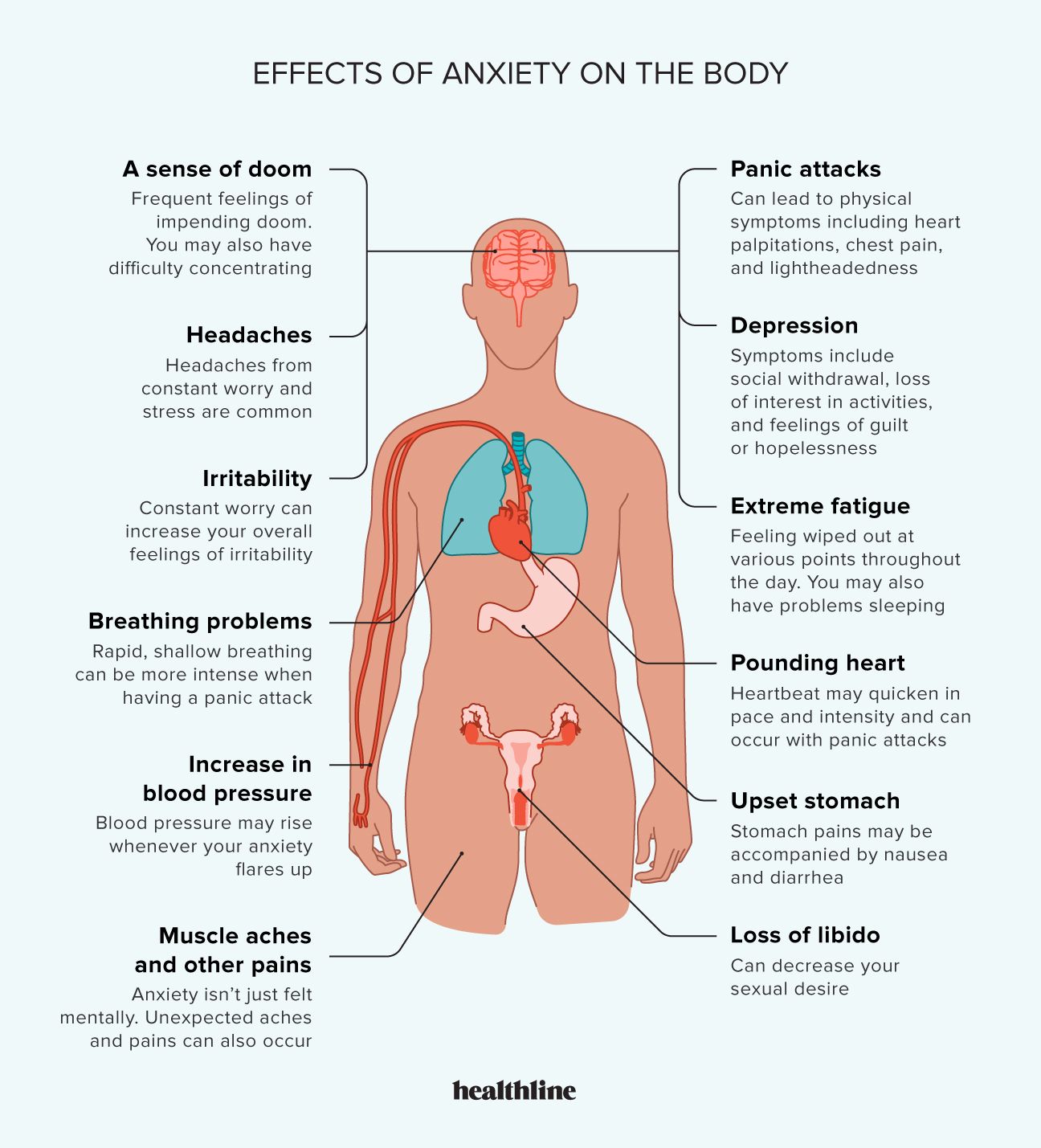Living with chronic anxiety can cause physical stress on your body, especially to your nervous, cardiovascular, digestive, immune, and respiratory systems.
Everyone has anxiety from time to time, but chronic anxiety can interfere with your quality of life. While perhaps most recognized for behavioral changes, anxiety can also have serious consequences on your physical health.
Read on to learn more about the major effects anxiety has on your body.

Anxiety is a natural part of life. For example, you may have felt anxiety before addressing a group or in a job interview.
You may feel physical symptoms of anxiety,
- rapid breathing or heart rate
- lightheadedness or dizziness
- abdominal pain
- indigestion
- chest pain
- fatigue
- insomnia
- headache
In the short term, anxiety increases your breathing and heart rate, concentrating blood flow to your brain, where you need it. This very physical response is preparing you to face an intense situation.
If it gets too intense, however, you might start to feel lightheaded and nauseous. An excessive or persistent state of anxiety can have a devastating effect on your physical and mental health.
Anxiety disorders can happen at any stage of life, but they
Stressful life experiences
There are several types of anxiety disorders. They include the following.
Generalized anxiety disorder (GAD)
GAD is marked by excessive anxiety for no logical reason. The ADAA estimates GAD affects about 6.8 million adults in the United States a year.
GAD is diagnosed when extreme worry about a variety of things lasts
Social anxiety disorder
Social anxiety disorder involves a paralyzing fear of social situations and of being judged or humiliated by others. This severe social phobia can leave one feeling ashamed and alone.
About
Post-traumatic stress disorder (PTSD)
PTSD develops after witnessing or experiencing something traumatic. Symptoms can begin immediately or be delayed for years.
Common causes include war, natural disasters, or a physical attack. PTSD episodes may be triggered without warning.
Obsessive-compulsive disorder (OCD)
People with OCD may feel overwhelmed with the desire to perform particular rituals (compulsions) over and over again, or experience intrusive and unwanted thoughts that can be distressing (obsessions).
Common compulsions include habitual handwashing, counting, or checking something. Common obsessions include concerns about cleanliness, aggressive impulses, and the need for symmetry.
Phobias
Phobias include fear of tight spaces (claustrophobia), fear of heights (acrophobia), and many others. You may have a powerful urge to avoid the feared object or situation.
Panic disorder
This causes panic attacks, spontaneous feelings of anxiety, terror, or impending doom. Physical symptoms include heart palpitations, chest pain, and shortness of breath.
These attacks may occur at any time. You can also have another type of anxiety disorder along with panic disorder.
Long-term anxiety and panic attacks can cause your brain to release stress hormones on a regular basis. This can increase the frequency of symptoms, such as headaches, dizziness, and depression.
When you feel anxious and stressed, your brain floods your nervous system with hormones and chemicals designed to help you respond to a threat. Adrenaline and cortisol are two examples.
While helpful for the occasional high-stress event, long-term exposure to stress hormones can be more harmful to your physical health in the long run. For example, long-term exposure to cortisol can contribute to weight gain.
Anxiety disorders can cause rapid heart rate, palpitations, and chest pain. You may also be at an increased risk of high blood pressure and heart disease. If you already have heart disease, anxiety disorders
Anxiety also affects your excretory and digestive systems. You may have stomachaches, nausea, diarrhea, and other digestive issues. Loss of appetite can also occur.
There may be a connection between anxiety disorders and the development of irritable bowel syndrome (IBS) after a bowel infection. IBS can cause vomiting, diarrhea, or constipation.
Anxiety can trigger your flight-or-fight stress response and release a flood of chemicals and hormones, like adrenaline, into your system.
In the short term, this increases your pulse and breathing rate, so your brain can get more oxygen. This prepares you to respond appropriately to an intense situation. Your immune system may even get a brief boost. With occasional stress, your body returns to regular functioning when the stress passes.
But if you experience chronic stress, your body never gets the signal to return to regular functioning. This can weaken your immune system, leaving you more vulnerable to viral infections and frequent illnesses.
Also, your routine vaccines may not work as well if you have anxiety.
Anxiety causes rapid, shallow breathing. If you have chronic obstructive pulmonary disease (COPD), you may be at an increased risk of hospitalization from anxiety-related complications. Anxiety can also make asthma symptoms worse.
Anxiety disorder can cause other symptoms, including:
If you have PTSD, you may experience flashbacks, reliving a traumatic experience over and over. You might get angry or startle easily, and perhaps become emotionally withdrawn.
Other symptoms of PTSD include nightmares, insomnia, and sadness.
